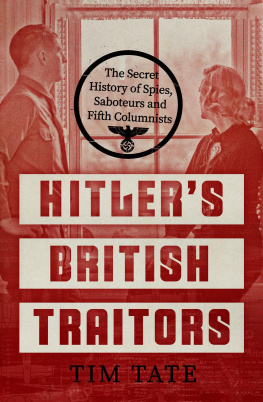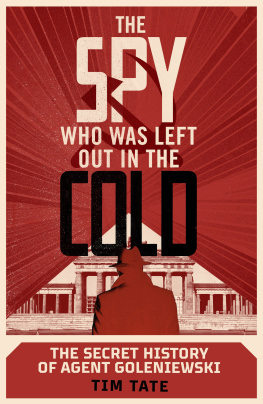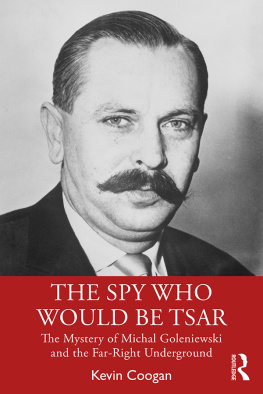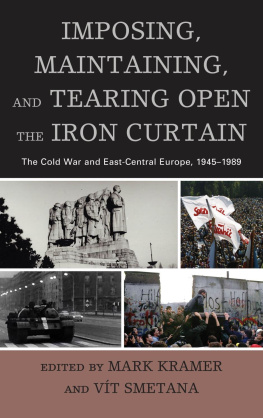Contents
Guide
Pagebreaks of the print version

The author and publisher have provided this e-book to you for your personal use only. You may not make this e-book publicly available in any way. Copyright infringement is against the law. If you believe the copy of this e-book you are reading infringes on the authors copyright, please notify the publisher at: us.macmillanusa.com/piracy.
Dedicated to Janice Watts, who many years ago gave an awkward and unpromising adolescent a holiday job in her remarkable independent bookshop, and fired a lifelong love affair with the printed page.
She would have had no reason to remember. But he has never forgotten.
Intelligence work was, by its nature, a game of liars poker,
played with a marked deck and counterfeit money.
Nelson DeMille, Up Country
5 p.m.: Mitte District, East Berlin
In the growing dark, hunched against the bite of the Berlin winter, a Stasi spy kept close watch on the communal entrance to the apartment block at number 54 Wollinerstrasse.
Earlier that afternoon he had logged the arrival of a tall, powerfully built man whose features and distinctive full moustache matched the description of Roman Tarnowski, a Polish intelligence agent now under suspicion by his masters in Warsaw as well as the East German secret police.
Twenty minutes later the door opened and the same man emerged, accompanied by a slight and pretty brunette, evidently some years younger than him; each was carrying only a small bag. The spy noted the time in his log and watched as the couple walked quickly away from the building, heading towards the solitary road sign which marked the border with West Berlin, just 150 metres away.
5.30 p.m.: CIA Berlin Operating Base, American Consulate, Zehlendorf, West Berlin
On the US Missions telephone switchboard a light flashed for the CIA s Berlin Operating Base emergency number. The caller identified himself with an agreed cover name: Herr Kowalski.
The call signalled the imminent arrival of a mysterious and eagerly awaited defector. Although he had, for almost three years, risked his life to send thousands of pages of top-secret Soviet bloc documents to the West, he had done so anonymously: since the first package arrived in April 1958, all the CIA had known was the mans self-chosen cover name Heckenschuetze, or Sniper and that forensic analysis suggested he worked for the Polish Intelligence Service.
6.06 p.m.: Clayallee, West Berlin
A West Berlin taxi pulled up beside the uniformed military police guarding the American Consulate. A heavily set man, sporting a luxuriant moustache, emerged and helped a slim younger woman from it; they looked around, evidently apprehensive, then walked tentatively up the steps and into the safety of US territory.
After some discussion, the man confirmed he was Heckenschuetze, and disclosed his true identity: Micha Goleniewski, a Lieutenant Colonel in Polands intelligence service, Urzd Bezpieczestwa ( UB ). Until January 1958 he had held the post of deputy chief of military counterintelligence, and he was currently the head of the scientific branch of Polish foreign intelligence; as well as working for the Polish spy agency he was simultaneously employed by the KGB in Moscow, and had access to many of its most sensitive secrets. His companion, he explained, was his East German mistress; she, too, wished to defect.
The CIA station team was jubilant. Agent Sniper, the most senior and devastating Soviet bloc intelligence defector the Agency had ever known, was in the bag, and was ready to hand over a wealth of details: names and cover names of Communist spies in the West, as well as the locations of their operations.
Had the Agency been able to look just a few months into the future it might have been less triumphant. But as they prepared to exfiltrate their catch from Berlin, they had no inkling of the problems that Goleniewskis identity would cause much less the decades of chaos and paralysis which his revelations would inflict on the CIA , the British Security Service ( MI 5) and the entire network of Western intelligence agencies.
E VEN FOR A spy and whatever else he might have been he was a devastatingly successful spy the man had a remarkable collection of identities.
To Polands intelligence service he was Lieutenant Colonel Micha Goleniewski, a forty-year-old decorated former Army officer, married to a Russian woman and the father of three children and who, by the end of the 1950s, headed one of its most important espionage departments, while simultaneously working for the KGB in Moscow. In the same period, members of Polands anti-Communist movement knew and feared him as Dr Roman Tarnowski, a relentless interrogator of dissidents who worked for the General Prosecutors Office.
In East Germany, to which he travelled regularly, the files of East Germanys secret police, the Stasi, also recorded his name as Tarnowski though without the honorific doctorate. Meanwhile, Irmgard Kampf, his East German mistress in the Soviet sector of Berlin, to whom he funnelled thousands of dollars, deutschmarks and pounds sterling all stolen from Soviet bloc spy funds believed him to be Jan Roman, a widowed Polish newspaper journalist.
In the United States, the CIA registered him under his self-chosen cover name of Heckenschuetze, or Sniper, and reported that he was its most valuable undercover agent behind the Iron Curtain: a volunteer spy who smuggled thousands of pages of top-secret intelligence documents and microfilms to America, and who exposed Communist agents throughout Europe and the West.
In Britain, the Security Service, MI 5, assigned him its own cryptonym, LAVINIA , and marvelled at the quality of information he provided about KGB agents who had burrowed into its sister organization, MI 6, as well as into some of the countrys most sensitive military establishments.
When he defected in January 1961, across divided Berlin and with Soviet bloc intelligence agents hard on his heels, he initially announced himself to US Consular officials as Herr Kowalski, before telling them that he was really Lieutenant Colonel Micha Goleniewski. But twenty-four hours later, as he prepared to board the US Military Transport flight which smuggled him out of Germany, he had become Franz Roman Oldenburg an invented identity that he subsequently used to rent apartments in Arlington, Virginia, and New York. With the CIA s blessing, he also solemnly gave this entirely fictitious name for his bigamous marriage the first of two such weddings to Irmgard Kampf.
Two years later, to a succession of US Congressional Committees meeting in secret, and to successive occupants of the White House, his name was Martin N. Cherico. Yet simultaneously he was the beneficiary of a CIA -sponsored private Bill in the House of Representatives to grant him citizenship, under his real name: Micha M. Goleniewski.
But from early 1964 many of the White Russian diaspora and with them the most senior official of the Russian Orthodox Church in Exile accepted his claim to a very different identity and pedigree: they recognized him as Aleksei Nicholaevich Romanoff, the miraculously surviving son of the last Tsar, and self-proclaimed heir to the Imperial Russian throne. It was that highly improbable pretence which would cause him the most trouble.
















